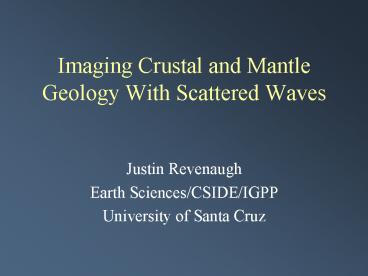Imaging Crustal and Mantle Geology With Scattered Waves - PowerPoint PPT Presentation
1 / 60
Title: Imaging Crustal and Mantle Geology With Scattered Waves
1
Imaging Crustal and Mantle Geology With Scattered
Waves
- Justin Revenaugh
- Earth Sciences/CSIDE/IGPP
- University of Santa Cruz
2
Acknowledgements
- Colin Reasoner (SAIC)
- Andrew Frederiksen (UCSC)
3
What are scattered waves?
- Scattered waves originate through the interaction
of primary (and scattered) waves with
heterogeneities. They do not exist in a
homogenous medium.
4
An Example of Seismic Scattering Precursors to
PKP
5
Precursors to PKP
6
Seismic Coda
7
Why Study Scattered Waves?
- Ignoring them doesnt make them go away
- Scattered waves can image geologic
contactstravel time tomography cannot - Sensitive to cracksuseful for understanding
stress variability - Necessary to separate earthquake source and
propagation-induced waveform complexity
8
Tomography vs Scattered-Wave Imaging
9
Migration Schematic
10
Scattered-Wave Travel Times Part 1
11
Scattered-Wave Travel Times Part 2
12
Teleseismic Event Distribution
13
Processing Flowchart
14
Source Deconvolution
15
Processing Flowchart
16
Migration Schematic
17
Processing Flowchart
18
Bootstrapping for Scattering Potential
19
P to P Scattering in the Mantle
20
P to P Scattering in the Mantle
21
P to P Scattering in the Mantle
22
P to P Scattering in the Mantle
23
P to P Scattering in the Mantle
24
Synthetic P to P Scattering in the Mantle
25
A Model for Mantle Scattering
26
Conclusions
- Subcrustal lithosphere subduction beneath the
Transverse Ranges is the dominant source of upper
mantle scattering in Southern California. - May imply through-going breaks in the lithosphere
matching breaks in the Ranges. - There are no big surprises lurking beneath
Southern California.
27
(No Transcript)
28
Resolution and Variance Tests
29
Aligned Seismograms
30
Scattering and Seismicity
31
Faulting Statistics
32
Seismicity Statistics
33
Seismicity Distribution Part 1
34
Seismicity Distribution Part 2
35
Landers Region
36
Along-Fault Averaging Scheme
37
Along-Fault Scattering and Seismicity Variations
38
Along-Fault Scattering and Slip Variation
39
San Jacinto Fault Zone
40
San Jacinto Scattering Resolution
41
San Jacinto Scattering Variance Tests
42
San Jacinto Regional Scattering
43
Along-Fault Scattering and Seismicity Variations
44
Transverse Ranges Scattering
45
Along-Fault Scattering and Seismicity Variations
46
Transverse Ranges Seismicity
47
Central California Faults
48
San Andreas Segmentation
49
San Andreas Offset Estimation
50
Realigned San Andreas Profiles
51
San Andreas Segmentation
52
San Andreas Segmentation
53
San Jacinto Regional Scattering
54
San Jacinto Offset Estimation
55
Realigned San Jacinto Profiles
56
San Jacinto Aligned Scattering
57
Perturbed Fault Zones
58
Perturbed SJFZ Results
59
Conclusions
- Scattered-wave imaging with teleseismic P works.
- Crustal scattering is pattern predictive of
seismicity and co-seismic slip - A large portion of the scattering heterogeneity
translates coherently with the fault - Pre-fault structure exerts a significant
influence on seismogenesis
60
Conclusions
- Results can be used to assess seismic hazard
- Pinpoint areas of greatest slip
- Recognize regions of seismic deficit
- Method has potential applications in hydrogeology
- Crack detection, fracture density mapping
- Passive or active mode































